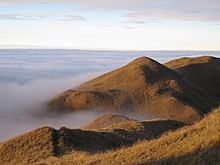
Indigenous Philippine folk religions are the distinct native religions of various ethnic groups in the Philippines, where most follow belief systems in line with animism. Generally, these Indigenous folk religions are referred to as Anito or Anitism or the more modern and less ethnocentric Dayawism, where a set of local worship traditions are devoted to the anito or diwata (and their variables), terms which translate to Gods, spirits, and ancestors.[1][2][3][4] Many of the narratives within the indigenous folk religions are orally transmitted to the next generation, but many have traditionally been written down as well. The Spanish have claimed that the natives did not have religious writings.
The profusion of different terms arises from the fact that these Indigenous religions mostly flourished in the pre-colonial period before the Philippines had become a single nation.[5] The various peoples of the Philippines spoke different languages and thus used different terms to describe their religious beliefs. While these beliefs can be treated as separate religions, scholars have noted that they follow a "common structural framework of ideas" which can be studied together.[3] The various Indigenous Philippine religious beliefs are related to the various religions of Oceania and the maritime Southeast Asia, which draw their roots from Austronesian beliefs as those in the Philippines.[4][6]
The folklore narratives associated with these religious beliefs constitute what is now called Philippine mythology, and is an important aspect of the study of Philippine culture and Filipino psychology.
- ^ Almocera, Ruel A., (2005) Popular Filipino Spiritual Beliefs with a proposed Theological Response. in Doing Theology in the Philippines. Suk, John., Ed. Mandaluyong: OMF Literature Inc. Pp 78-98
- ^ Maggay, Melba Padilla (1999). Filipino Religious Consciousness. Quezon City: Institute for Studies in Asian Church and Culture.
- ^ a b Sitoy, T. Valentino Jr. (1985). A history of Christianity in the Philippines Volume 1: The Initial Encounter. Quezon City, Philippines: New Day Publishers. ISBN 9711002558.
- ^ a b Demetrio, Francisco R.; Cordero-Fernando, Gilda; Nakpil-Zialcita, Roberto B.; Feleo, Fernando (1991). The Soul Book: Introduction to Philippine Pagan Religion. GCF Books, Quezon City. ASIN B007FR4S8G.
- ^ Scott, William Henry (1994). Barangay: Sixteenth Century Philippine Culture and Society. Quezon City: Ateneo de Manila University Press. ISBN 971-550-135-4.
- ^ Osborne, Milton (2004). Southeast Asia: An Introductory History (Ninth ed.). Australia: Allen & Unwin. ISBN 1-74114-448-5.